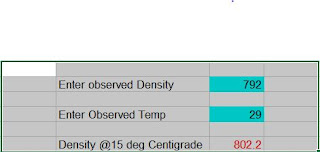- Myth of Petroleum Product test - Reference material Purity Part 3 of X
Myth - Requirement of Flash Point reference material purity is Analytic Grade (AR)
Fact : No, AR quality or highest quality flash point reference liquids are not required.
Some labs use pure chemicals like p-Xylene( 27 C), toluene (6 C), cyclohaxanone (43 C), 1-hexanol (60 C) etc of highest quality as reference material for checking/certifying Flash Point equipment. (Figures in bracket are approx. Flash Points). Several ISO 17025 Lab accreditation auditors also demand for highest quality reference material and some insist verification of flash point equipment quarterly with these AR grade reference material.
In my view, one need not to use AR grade reference materials for flash point testing equipment accuracy verification. Following are justification for this.
1) Reference IP-170 - ISO 13736, Flash Point Test Annex D, Apparatus verification,
Quoting.....
Quoting.....
This annex describes a procedure for producing a secondary working standard (SWS) and conducting verification checks using a SWS and a certified reference material (CRM).
The performance of the apparatus (manual or automated) should be verified on a regular basis using either a CRM produced in accordance with ISO Guide 34[2] and ISO Guide 35[3], or an in-house reference material/SWS prepared in accordance with one of the procedures given in D.2.2.
A secondary working standard (SWS) is a stable petroleum product or a single hydrocarbon or other stable substance with a flash point determined by either
a) testing representative subsamples at least three times using an instrument previously verified using a CRM, statistically analysing the results and, after the removal of any outliers, calculating the arithmetic mean of the results, or
b) conducting an inter-laboratory method-specific test programme utilizing at least three laboratories testing representative samples in duplicate. The assigned value of the flash point should be calculated after statistically analysing the inter-laboratory data.
In view of above any round robin correlation sample like ASTM PTP with accepted robust mean result for flash point is the best reference material.
Evaluate the test result as per D4 of this section of IP -170 test method.
If some statutory requirements like Indian explosive Rules - p-xylene can be used ONCE a YEAR, which in my opinion is not adding any technical extra value to accuracy.
2) Indian Standards 1448 - P : 20 Abel Flash Point Test method Annex B, specify using p-Xyelene as performance of test.
As per the above, p-Xylene having Relative density 0.860 to 0.866 at 60/60 F and purity of at least 95% and distillation range of 2 deg C max which should include boiling point 138.55 deg C.
You have to test flash point for 5 times with above mentioned p-Xylene and result must be within 0.5 deg C, most important it is to be noted that this Indian statutory requirement is silent on what exact flash point result should be obtained here.
This also imply without any doubt that quality of the reference material need not be of AR grade.
3) As per ASTM test methods D56 and D93, pure liquids with certified values and SWS can be used and result obtained should be within 0.7 times the Reproducibility of the test method.
Conclusion: No need to use every time AR grade reference material for flash point equipment verification. Round Robin petroleum samples like ASTM having certified robust mean value with reference document and well preserved in stable condition are the best option. Pure AR grade reference materials can be kept for only once a year Equipment certification.
Author's Profile
List of all blog articles on Petroleum QC by RJ Patel.
Follow me on twitter @RJPatel13 to get notification when my new post is available in my blog.
Author's Profile
List of all blog articles on Petroleum QC by RJ Patel.
Follow me on twitter @RJPatel13 to get notification when my new post is available in my blog.


Comments